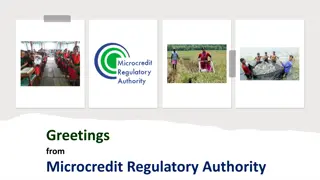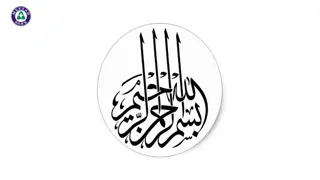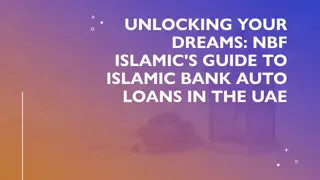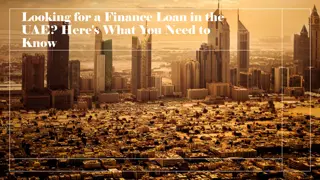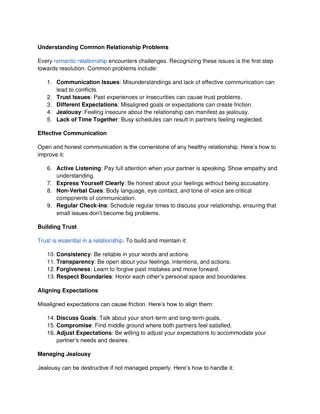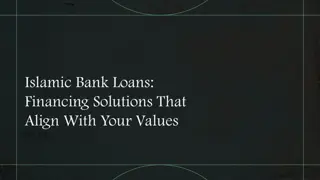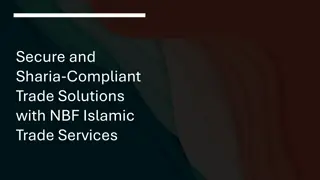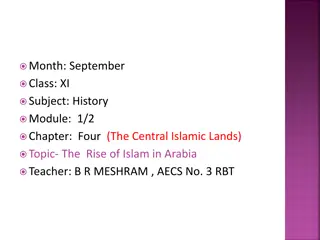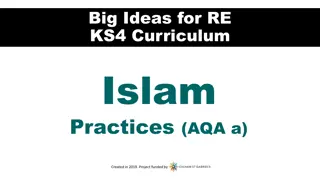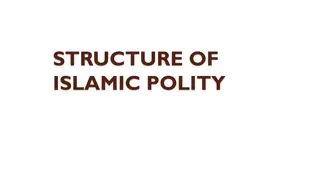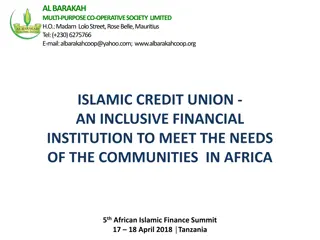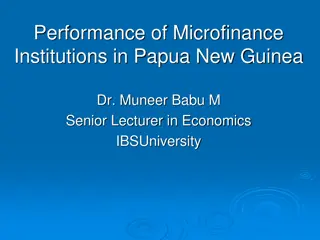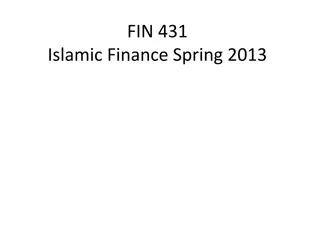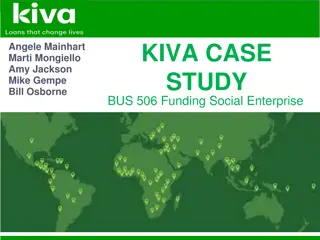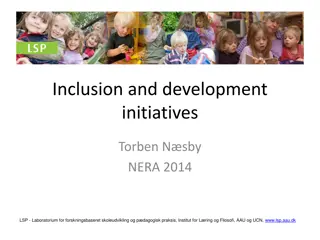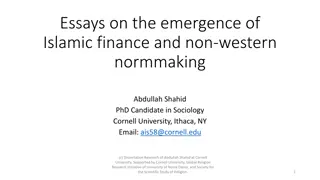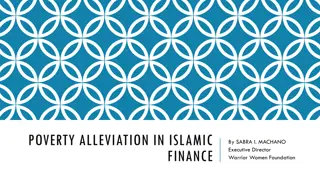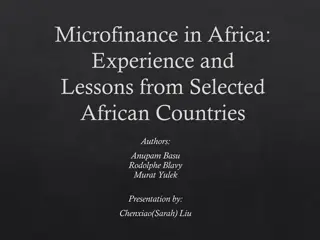Sustainable Financial Inclusion through Islamic Microfinance
CEO Abdul Ammar Mun'am presents an innovative approach to tackle poverty worldwide by addressing reasons such as high illiteracy rates, wealth concentration, and interest-based economic systems. He emphasizes the need for sustainable financial solutions like Islamic microfinance to empower the underprivileged and unbanked populations.
Download Presentation

Please find below an Image/Link to download the presentation.
The content on the website is provided AS IS for your information and personal use only. It may not be sold, licensed, or shared on other websites without obtaining consent from the author.If you encounter any issues during the download, it is possible that the publisher has removed the file from their server.
You are allowed to download the files provided on this website for personal or commercial use, subject to the condition that they are used lawfully. All files are the property of their respective owners.
The content on the website is provided AS IS for your information and personal use only. It may not be sold, licensed, or shared on other websites without obtaining consent from the author.
E N D
Presentation Transcript
Sustainable Financial Inclusion through Islamic microfinance; An innovative approach by Abdul Ammar Mun am
CEO and Founder of Aliqtisaad-International Center of Islamic Economics, Business and Finance Founder and Former Deputy Director of International Center of Research in Islamic Economics Founder and Former Director Project Development of AlMawakhat Islamic Microfinance Founder and Former Deputy Head of School of Islamic Economics, Business and Finance Former Business Development Executive of BankIslami Pakistan Limited
Poverty worldwide On average, according to a gallop survey, there are more than three billion people who are surviving just below the income of $ 2.50 a day Seven opulent people in the world possess more than the GDP of 41 downtrodden countries in the world. This equals to the gross income of 567 Million people Only Islamic world, which consists of 1.2 billion people out stretched from Senegal to Philippines, the rate of poverty, is sky- high except few countries of Southeast Asia and Middle East; out of 1.2 billion Muslims, 470 millions are at the lowest level of poverty and earning less than $2 each day
Reasons of sky-high Poverty High illiteracy rate Concentration of wealth in few hands Interest based economic systems Violation of human rights. The banking industry actually had no feasible and accessible loan facility solutions for the poor segments They provide loans and financing services only to the businessmen and industrialists more often. It is the case with over fifty Muslim countries and many other Muslims living in various countries around the globe as well
Cont Eighty percent of the world s population has no access to financial services; Due to The high cost of financing Extravagant cost of processing System of collaterals Exorbitant high rates of profit poor elimination rather poverty alleviation For Unbanked, Microfinance refers to making small loans available to poor people (especially those traditionally and financially excluded from financial services) through programs designed specifically to meet their particular needs and circumstances Microfinance, the term is used synonymous with microcredit mostly
Commonalities and Differences between Conventional Microfinance and Islamic Microfinance Conventional microfinance and Islamic microfinance have much in common. Both emphasize the good of the society as a whole. Both advocate entrepreneurship and risk sharing and believe that the poor should take part in such activities. Both focus on developmental and social goals. Both advocate financial inclusion. Both involve participation by the poor. There are however, some points of difference between the two such as financing for economically active, high cost of financing, high cost of processing; system of collaterals, high rates of profit and "women- only" and Muslim only approaches and so on
Prevailing Islamic Microfinance Models Murabaha Musharaka Mudarabah, Ijarah Ijarah Muntahiya Bit tmalik Al Qard ul Hassan And so on
Conventional and Islamic Microfinance Industry in Pakistan; Pakistan Microfinance Network (PMN) 39 MFPs Microfinance Providers include 11 Microfinance Banks, 12 Microfinance Institutions and 4 Rural Support Programs and 12 social sector organizations that provide microfinance as part of a multi- dimensional service offering Number of active borrowers reached 5.2 million by June 2017 a growth of 14 percent since December 2016 Gross loan portfolio increased to Rs171 billion, up 25 percent from Rs137 billion reported six months ago Average loan size stood at Rs44863, up from 41663 in December last year on the savings front, number of savers has surged to 25.2 million as of June 2017, up 9 percent from December 2016 level. There is higher growth in saving deposits, which have grown some 22 percent since December-end to Rs148 billion in June end. That reflects in a higher average savings balance, which reached Rs5852 in 2017.
Cont. The micro-insurance segment is not behind when it comes to growth. Number of policyholders has grown to 6.3 million as of June 2017, up 8 percent from December 2016. The sum insured has climbed to Rs168 billion, 12 percent higher compared to December 2016. Together, the MFPs have expanded microfinance coverage to 106 districts in Pakistan as of June end. The microfinance penetration rate is reported by PMN at roughly 25 percent, based on an estimated potential market size of 20.5 million according to data released by the (PMN Review, 2017).
Cont.. The MFPs have doubled the number of active borrowers between 2011 and 2016 and in year 2017, too, the tally is getting bigger. So there is work to be done. The addressable market is still very large, and apparently growing. A loan-book of over Rs400 billion is needed to serve 10 million micro borrowers. That means equity capital must reach at least Rs40 billion. To serve the credit demand of 10 million borrowers, the MFPs need to disburse additional Rs220 billion over existing loan-book size. It likely won t be enough. Commercial banks will need to play a role, too. Perhaps the central bank can nudge them in that direction. Out of the 82% of Pakistan s population that is currently unbanked, the size of the potential microfinance market is estimated to be around 30 million. These 30 million people are not only bankable, but also make less than Rs 25, 000 a month a regulatory condition.
Criticism on the prevailing models of Islamic Microfinance Organizations in Pakistan "Women-Only" and Muslims-Only Approaches High cost of financing, High cost of processing and longer time wasting processing Tough System of collaterals Specific Area approach Only few or single mode of financing Only donor dependant and charity based approach Limited range of products Short built welfare experience Ineffective Operational Efficiency of Business Models ..Cont
Cont. Lack of establishment of Branchless Micro finance Banking Lack of Economic sustainability and viability Non productive Risk Management Neglected component of Islamic Banking No Separate Islamic Microfinance Division at central Bank e.g. at SBP Most inactive and slow working of Islamic Microfinance Network in Pakistan in comparison with Microfinance Network of Pakistan. Not up to the Mark Business development support Miscellaneous Pitfalls
The Proposed Islamic Microfinance Business Model-PIMBM for Microfinance Providers There should be two major portions in the business model. Zakat/Sadqat Based Model Famous Hadith A man of the Ansaar community came down to the Prophet (Peace Be upon Him) and begged from him. He (the Prophet) asked: Have you nothing in your house? He (the man) replied: Yes, a piece of cloth, which we wear, or which we spread (on the ground), and a wooden bowl from which we drink water. He (the Prophet) said: Bring them to me. He (the man) then brought these articles to him and he (the Prophet) took them in his hands and asked to the assembly of people: Who will buy these? A man said: I shall buy them for one dirham. He (the Prophet) asked twice or thrice: Who will offer more than one dirham?Another man said: I shall buy them for two dirhams.
Cont.. He (the Prophet) gave these to him and took the two dirhams and, giving them to the man of the Ansar, he said: Buy food with one of them and hand it to your family, and buy an axe and bring it to me. He then brought it to him. The Prophet (peace be upon him) fixed a handle on it with his own hands and said: Go, gather firewood and sell it, and do not let me see you for a fortnight. The man went away and gathered firewood and sold it. When he had earned ten dirhams, he came to him and bought a garment with some of them and food with the others. The Prophet (peace be upon him) then said: This is better for you than that begging should come as a spot on your face on the Day of Judgment. Begging is right only for three people: one who is in grinding poverty, one who is seriously in debt, or one who is responsible for compensation and finds it difficult to pay
The components of this Hadith fundamental conditions of a successful Microfinance program Access of the poorest of the poor to the program Careful assessment of the financial health of the poor; enquiry blended with empathy; insistence on contribution and beneficiary stake Transformation of unproductive assets of the beneficiary into income-generating ones through rigorous valuation (on the basis of price discovery through auction method); involvement of the larger community in the process Meeting of basic needs on a priority basis and investment of the surplus in a productive asset
Cont.. Direct involvement of the program in capacity building in the run up to income generation and technical assistance to the beneficiary; commitment of top management of the program Technical assistance in the form of imparting requisite training to the beneficiary for carrying out the business plan/ income- generating project; monitoring through a time-bound schedule and impact assessment through a feed-back mechanism Transparent accounting of operational results and liberty to use part of income to meet higher needs Strong discouragement to seeking charity
Cont. MFPs should the policy to finance small businesses either in the shape of cash or sellable products from Zakat resources in order to meet the needs of people in society. The effort of Sadqat is in accordance with the true spirit of Fi sabeelillah and essence of Mawakhat of Madina and teachings of the Qur an and Hadit h. It would also be based on Fard-e-Kifaya , Falah , and Ihsaan .
Economically Sustainable Model Islamic finance scholars have argued that the provision of equity based financing by Islamic financial institutions will facilitate toward achieving the Islamic socio-economic objectives which include social justice, economic growth, efficiency and stability For example, diminishing Musharkah, an equity-based financing instrument, is better than debt-based financing because of its flexibility and end result in the ownership of assets on the part of the customer So diminishing Musharkah as an innovative mode of financing and should be a preferred instrument of financing by Islamic microfinance institutions. So under this model, MFP should offer its products but not limited to mode of diminishing Musharkah.
cont Do not stick to one mode of finance Equity based modes rather than debt based modes The tools used for risk mitigation are Personal Guarantee, Post dated Cheques, Jewellery, Mortgage, Masjid Reference and Group Lending Principle. Same can be opted but not limited to with case to case dealing in proposed model. All applicants from all over the country would apply through union council offices, without any processing fee Flawless security would provided by one of above guarantees
Cont. Product Line: Do not stick to one product Branchless and mobile banking Inclusive Strategy of Proposed Islamic Microfinance Business Model for Microfinance Providers
The Achievable level I strongly believe that we can create a poverty-free world, if we want to in that kind of world, [the] only place you can see poverty is in the museum. These are the charismatic words of Muhammad Yunus, pioneer of the Grameen Bank and father of microfinance. The Grameen Bank, founded in 1983, offered poor communities an alternative to the rich moneylenders and traders that charged usurious interest rates. By achieving 98% repayment rates from the very poor in Bangladesh, Yunus showed the world that the poor are bankable and set a trend in the international development community. Why not we?
Suggestions, Criticism and Feedback munam1111@gmail.com AbdulAmmarMunam AbdulAmmarMunam


